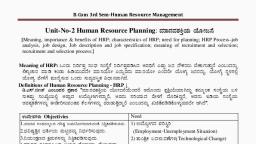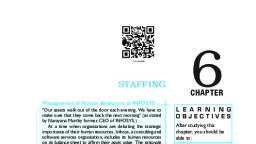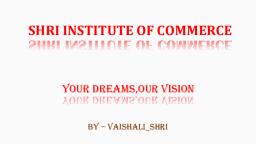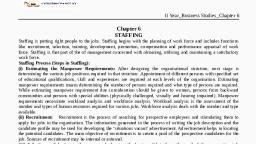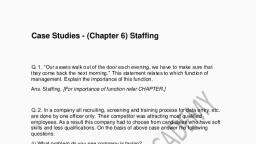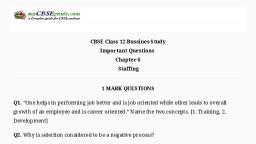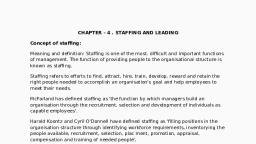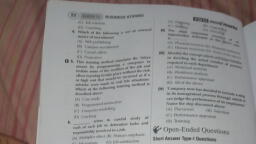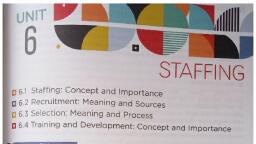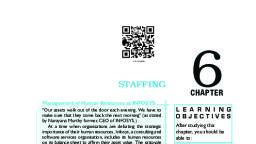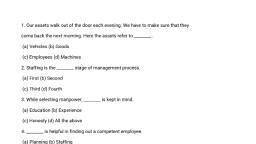Page 1 :
UNIT 6, , , , STAFFING, , , , Staffing means putting people to jobs. It begins with human resource planning, and includes different other functions like recruitment, selection training,, development, promotion and performance appraisal of work force., , Need and Importance of Staffing :, 1, Obtaining Competent personal : Proper staffing helps in discovering and, obtaining competent personal for various jobs., , 2. Higher performance : Proper staffing ensures higher performance by, putting right person on the right job., , 3. Continuous growth : Proper staffing ensures continuous survival and, growth of the enterprise., , 4. Optimum utilisation of human resources :- it prevents under - utilisation, of personnel and high labour cost., , 5. Improves job satisfaction : It improves job satisfaction and morale of, employee., , Human Resource Management : (HRM), , The function of Human Resource Managent is to provide skill human elements, to the enterprise. Therefore big enterprise create a separate department called, HRD. This department work under H.R.M. Managers., , Definition : Human Resource managent is the recruitment selection,, development, utilisation, compensation and motivation of human resources of, the organisation., , Staffing as Part of Human Resources Management : The scope of Human, Resources Management is big than staffing. It involves staffing, keeping, personal record, providing expert service and other work., , , , 40 Xi - Business Studies
Page 2 :
3. Lengthy Process : It takes more time than other process., , (B) Selection : Selection is the process of choosing from among the candidates, from within the org. or from the outside, the most suitable person from, the current position or for the future position,, , PROCESS bi SELECTION, , ae ae seen hes ty come, , Checks = decision Exam Otter o, employment, , (C) Training : Training is the act of increasing the knowledge and technical, skills of an employee for doing a particular job efficiently., , Benefits to the Organisation :It enhances employee productivity and quality,, , , , 1, 2. Training increases employee moral., 3. Employee got new Tech. knowledge., 4. Efficient uses of machine., , Benefits to the Employee :, Improved skills and knowledge of employee, , Increased performance by the individual help him to earn more,, Less accidents., , Training increases the satisfaction and morale of employee., , Training Method, , (A) On the Job Method :- It refers to the method that are applied to the work, place, while the employee is actually working. It means learning while, doing ., , 1, Apprenticeship Programme Training + A master worker or a trainer is, appointed who guides the worker regarding the skill of job., , 2. Coaching : In this method, the superior guides and instructs the trainee, as a a coach., , 3. Job Rotation : In this method employee is transfer to other department, or other shift., , = SPS, , , , 43 Xil- Business Studies
Page 3 :
Process of staffing :, , , , , , , , , , , , , , , , , , Components of Staffing, , (A) Recruitment (8) Selection (C) Training. Thus, Recruitment + Selection, + Training = Staffing., , (A) Recruitment : Recruitment may be defined as the process of searching for, prospective employee and stimulating them to apply for job in the, Organisation., , Sources of Recruitment :(A) Internal Source (B) External Sources, , Internal Sources of Recruitment :- Internal sources refer to inviting, candidates from within the Organisation, Following are important sources, of internal recruitment., , 1, Transfer :- It involves the shifting of an employee from one job of another,, from one department to another or from one shift to another shift., , 2. Promotions : It refers to shifting an employee to a higer position carrying, higher responsibilities, prestige, facilities and pay., 3. Lay off : To recall the temporarty worker for work is called Lay-off., , Advantages of Internal Sources Recruitment :, (1) Employees are motivated to improve their performance,, , (2) Intermal recruitment also simplifies the process of selection & placement., (3) No wastage of time on the employee training and development., (4) Filling of jobs internally is cheaper., , , , a1 Xi Business Studies
Page 4 :
Limitation of Internal Sources :, a), (2), @), (4), , The scope for induction of fresh talent is reduced., , The employee may become lethargic., , The spirit of competition among the employees may be hampered., Frequent transfers of employees may often reduce the productivity of the, Organisation., , External Sources of Recruitment :, 1,, , &, , Direct Recruitment ; Under the direct Recruitment a notice is placed on, the notice board of the enterprise specifying the details of the job, available,, , Casual callers : Many reputed business org. keep a data base of, unsolicited applicants in their office. These list can be use for Recruitment., , Advertisement : - Advertisement in newspaper is generally used when a, wider choice is required., , Employment Exchange : Employment exchange is regarded as a good, source of Recruitment., , Compus recruitment and labour contractors can be used for the purpose., , Merit of External Sources :, 1,, , Qualified Personnel : By using external source of recruitment the, management can attract qualified and trained people to apply for the, vacant job in the org., , Wider Choice : The management has a winder choice selecting the people, for employment., , Fresh Talent : It provide wider choice and brings new blood in the org., , Competitive Spirit : If a company taps external sources, the staff will have, to compete with the outsiders., , Limitations of External Sources of Recruitment :, 1,, , Dissatisfaction among existing employee :- Recruitment from outside, may causes dissatisfaction among the employees. They may feel that their, chances of promotion are reduced., , Costly process : A lot of money has to be spent on advertisement, therefore this is costly process., , , , 42 Xil- Business Studies
Page 5 :
(B) Off the Job Method : These methods are used away from the work place,, , It means learning before doing., , Class room lectures ; The lecture approach is well adapted to convey, specific information. The use of audio-visuals can often make a formal, classroom., , Films : They can provide information to the employee., , Case study : Trainee study the cases to determine problems & analyses, causes., , Computer modelling - Training provide to the employee by the help of, computer., , One Marks Questions :, Se ™~ Of ere PSP, , z=, , Explain the meaning of Staffing ., , Define Placement ., , Why is selection considered to be a negative Process., Give one advantage of Job Rotation training., , State one objective of Preliminary screening., , What is interview?, , What do you mean by on the Job Training?, , What do you mean by Recruitment?, , Define Lay off., , . Give the last steps of staffing process., ll., , Give the first steps of selection process., , 3 or 4 Marks Questions :, Explain any three types of selection Test., Explain the meaning of selection and training., , Internal sources of Recruitment are better than external sourcs of, Recruitment . Give reasons in support of your answer., , Write the difference between training and Development., , , , 44 Xi Business Studies
